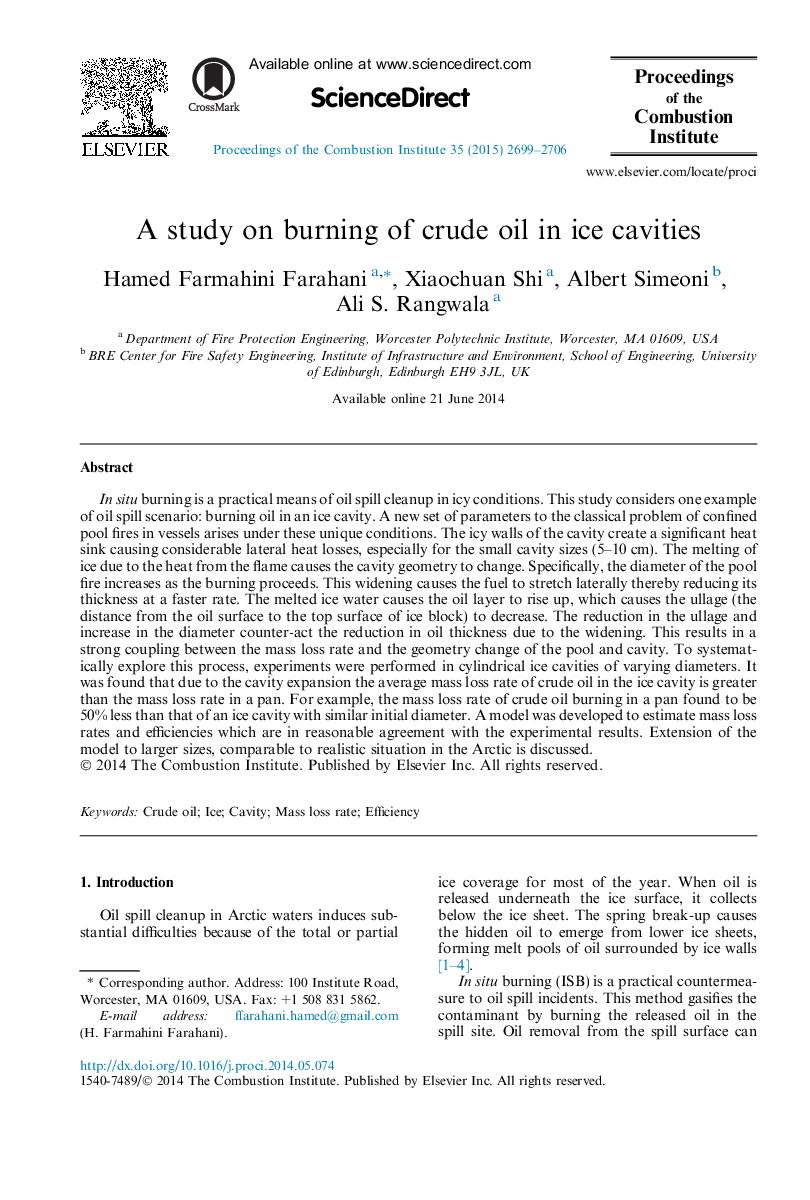| کد مقاله | کد نشریه | سال انتشار | مقاله انگلیسی | نسخه تمام متن |
|---|---|---|---|---|
| 4915518 | 1427919 | 2015 | 8 صفحه PDF | دانلود رایگان |
عنوان انگلیسی مقاله ISI
A study on burning of crude oil in ice cavities
ترجمه فارسی عنوان
مطالعه بر سوزاندن نفت خام در حفره های یخ
دانلود مقاله + سفارش ترجمه
دانلود مقاله ISI انگلیسی
رایگان برای ایرانیان
کلمات کلیدی
نفت خام، یخ، حفره، میزان تلفات جرم، بهره وری،
ترجمه چکیده
سوزاندن در محل، یک ابزار عملی برای پاکسازی نشت نفت در شرایط یخ است. این مطالعه یک نمونه از سناریوی نشت نفت را ذکر می کند: سوختن روغن در یک حفره یخ. مجموعه ای جدید از پارامترهای مربوط به مسئله کلاسیک استخر های محدود در آتش سوزی ها در زیر این شرایط منحصر به فرد ایجاد می شود. دیواره های یخ زده حفره موجب ایجاد ناپایداری گرمای قابل توجهی می شود که باعث کاهش قابل توجه حرارت گرما می شود، بخصوص برای اندازه های کوچک حفره (5-10 سانتیمتر). ذوب یخ به علت گرما از شعله باعث تغییر هندسه حفره می شود. به طور خاص، قطر استخر آتش افزایش می یابد به عنوان سوزش درآمد حاصل می شود. این گسترش باعث می شود که سوخت به صورت جانبی بچرخد و ضخامت آن را با سرعت بیشتری کاهش دهد. آب یخ ذوب باعث می شود که لایه ی نفت افزایش یابد، که موجب می شود تا تخلیه (فاصله از سطح روغن به سطح بالای یخ بلوک) کاهش یابد. کاهش در تخلیه و افزایش قطر در مقابل مقابله با کاهش ضخامت روغن به دلیل گسترش. این نتیجه یک اتصال قوی بین میزان تلفات جرم و تغییر هندسه استخر و حفره است. برای بررسی سیستماتیک این فرایند، آزمایشات در حفره های استوانه ای یخ از قطرهای مختلف انجام شد. مشخص شد که با توجه به گسترش حفره، متوسط میزان تلفات نفت خام در مخزن یخ بیشتر از میزان تلفات در یک تابه است. به عنوان مثال، میزان تلفات جرم نفت خام در یک پان 50٪ کمتر از حفره یخ با قطر اولیه مشابه است. یک مدل برای برآورد میزان تلفات از دست رفته و راندمان کارآیی طراحی شده است که با نتایج تجربی منطبق است. گسترش مدل به اندازه های بزرگتر، قابل مقایسه با وضعیت واقع بینانه در قطب شمال است.
موضوعات مرتبط
مهندسی و علوم پایه
مهندسی شیمی
مهندسی شیمی (عمومی)
چکیده انگلیسی
In situ burning is a practical means of oil spill cleanup in icy conditions. This study considers one example of oil spill scenario: burning oil in an ice cavity. A new set of parameters to the classical problem of confined pool fires in vessels arises under these unique conditions. The icy walls of the cavity create a significant heat sink causing considerable lateral heat losses, especially for the small cavity sizes (5-10Â cm). The melting of ice due to the heat from the flame causes the cavity geometry to change. Specifically, the diameter of the pool fire increases as the burning proceeds. This widening causes the fuel to stretch laterally thereby reducing its thickness at a faster rate. The melted ice water causes the oil layer to rise up, which causes the ullage (the distance from the oil surface to the top surface of ice block) to decrease. The reduction in the ullage and increase in the diameter counter-act the reduction in oil thickness due to the widening. This results in a strong coupling between the mass loss rate and the geometry change of the pool and cavity. To systematically explore this process, experiments were performed in cylindrical ice cavities of varying diameters. It was found that due to the cavity expansion the average mass loss rate of crude oil in the ice cavity is greater than the mass loss rate in a pan. For example, the mass loss rate of crude oil burning in a pan found to be 50% less than that of an ice cavity with similar initial diameter. A model was developed to estimate mass loss rates and efficiencies which are in reasonable agreement with the experimental results. Extension of the model to larger sizes, comparable to realistic situation in the Arctic is discussed.
ناشر
Database: Elsevier - ScienceDirect (ساینس دایرکت)
Journal: Proceedings of the Combustion Institute - Volume 35, Issue 3, 2015, Pages 2699-2706
Journal: Proceedings of the Combustion Institute - Volume 35, Issue 3, 2015, Pages 2699-2706
نویسندگان
Hamed Farmahini Farahani, Xiaochuan Shi, Albert Simeoni, Ali S. Rangwala,
